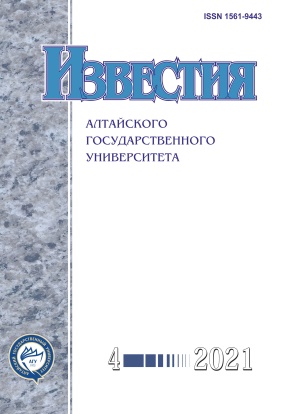Water Suspension and its Effect on Total Light Attenuation in Lake Waters
УДК 53:556.55
Abstract
The paper presents the data obtained by the authors in 2012-2021 during field trips to freshwater reservoirs of Altai Krai. According to hydro-optical measurements, values of light attenuation index in the range of 400-800 nm calculated using the natural logarithm varied greatly within 2.3-19.7 m-1 and 2.9-35.0 m-1 in the surface layer of lakes Lapa and Krasilovskoye during the study period. The relative spectral contribution of water suspension and contributions of yellow matter, chlorophyll, and pure water constituents at wavelengths of 430, 550, and 670 nm were estimated to assess the optical effect of water suspension on the total light attenuation index. The calculation results demonstrated that water suspension had the maximum effect on light attenuation in waters of eutrophic lake Lapa during the autumn-winter period. The maximum effect at all three wavelengths was observed in autumn of 2015, and the contribution of water suspension to light attenuation reached 88.5%, whereas its minimum (1.8-2.4 %) was recorded in 2017. The maximum contribution of water suspension on light attenuation in waters of eutrophic-hypereutrophic lake Krasilovskoye slightly exceeded the value of 70% during the winter of 2014. The next maximums were revealed during the spring of 2014 and had values of 71.3 % at λ =430 nm and 71.1 % at λ =550 nm.
Optical microscopy was used to estimate the size and concentration of water suspense particles. The average weighted value of radius for water suspense particles in the surface layer of lakes Lapa and Krasilovskoye was found to be 1.2 and 1.4 microns, respectively. The average particulate count for water suspense during the observation period varied in the range of 0.2·106 cm-3-14.7·106 cm-3 with values of 3.3·106 cm-3 for lake Lapa and 3.0·106 cm-3 for lake Krasilovskoye.
Downloads
Metrics
References
Лопатин В.Н., Приезжев А.В., Апонасенко А.Д., Шепелевич Н.В., Лопатин В.В., Пожиленкова П.В., Простакова И.В. Методы светорассеяния в анализе дисперсных биологических сред. М., 2004.
Reinart A., Paavel B., Pierson D., Strombeck N. Inherent and apparent optical properties of Lake Peipsi, Estonia // Boreal Env. Res. 2004. № 9.
Mitchell B.G., Kahru M., Wieland J., Stramska М. Determination of spectral absorption coefficients of particles, dissolved material and phytoplankton for discrete water samples // Ocean Optics Protocols for Satellite. Ocean Color Sensor Validation. 2002. Revision 3. Vol. 2. Chapter 15.
Onderka M., Rodny M., Veliskova Y. Suspended particulate matter concentrations retrieved from self-calibrated multispectral satellite imagery // J. Hydrol. Hydromech. 2011. Vol. 59. № 4. DOI: 10.2478/v10098-011-0021-9.
Korosov A.A., Pozdnyakov D.V., Shuchman R., Sayers M., Sawtell R., Moiseev A.V Bio-optical retrieval algorithm for the optically shallow waters of Lake Michigan. I. Model description and sensitivity/robustness assessment // Transactions of KarRC RAS. 2017. № 3. DOI: 10.17076/lim473.
Shuchman R.A., Leshkevich G., Sayers M.J., Johengen T.H., Brooks C.N., Pozdnyakov D. An algorithm to retrieve chlorophyll, dissolved organic carbon, and suspended minerals from Great Lakes satellite data // J. Great Lakes Res. 2013. Vol. 32.
Churilova T.Ya., Moiseeva N.A., Latushkin А.А., Suslin V.V., Usoltseva M.V, Zakharova Yu.R., Titova L.A., Gnatovsky R.Yu., Blinov V.V. Preliminary results of bio-optical investigations at Lake Baikal // Limnol. and Freshwat. Biol. 2018. № 1. DOI:10.31951/2658-3518-2018-A-1-58.
Shi L., Mao Z., Wu J., Liu M., Zhang Y., Wang Z. Variations in spectral absorption properties of phytoplankton, non-algal particles and chromophoric dissolved organic matter in Lake Qiandaohu // Water. 2017. № 9. P 352. DOI:10.3390/w9050352.
Clavano W.R., Boss E., Karp-Boss L. Inherent optical properties of non-spherical Marine-like particles - from theory to observation // Oceanogr. and Marin. Biol.: An Ann. Rev. 2007. № 45.
Акулова О.Б. Разработка методов и измерительновычислительного комплекса для оценки экологически значимых гидрооптических характеристик пресноводных водоемов (на примере озер Алтайского края) : Дис. ... канд. тех. наук. Барнаул, 2015.
Копелевич О.В. Малопараметрическая модель оптических свойств морской воды // Оптика океана. Т. 1. Физическая оптика океана / Под ред. А.С. Монина. М., 1983.
Pope R.M., Fry E.S. Absorption spectrum (380-700 nm) of pure water. II. Integrating cavity measurements // Applied Optics., 1997. Vol. 36. № 33.
Smith R.C., Baker K.S. Optical properties of the clearest natural waters (200-800 nm) // Applied Optics. 1981. Vol. 20. № 2.
Copyright (c) 2021 Ольга Борисовна Акулова , Владимир Иванович Букатый, Владимир Викторович Кириллов, Олег Михайлович Фроленков

This work is licensed under a Creative Commons Attribution 4.0 International License.
Izvestiya of Altai State University is a golden publisher, as we allow self-archiving, but most importantly we are fully transparent about your rights.
Authors may present and discuss their findings ahead of publication: at biological or scientific conferences, on preprint servers, in public databases, and in blogs, wikis, tweets, and other informal communication channels.
Izvestiya of Altai State University allows authors to deposit manuscripts (currently under review or those for intended submission to Izvestiya of Altai State University) in non-commercial, pre-print servers such as ArXiv.
Authors who publish with this journal agree to the following terms:
- Authors retain copyright and grant the journal right of first publication with the work simultaneously licensed under a Creative Commons Attribution License (CC BY 4.0) that allows others to share the work with an acknowledgement of the work's authorship and initial publication in this journal.
- Authors are able to enter into separate, additional contractual arrangements for the non-exclusive distribution of the journal's published version of the work (e.g., post it to an institutional repository or publish it in a book), with an acknowledgement of its initial publication in this journal.
- Authors are permitted and encouraged to post their work online (e.g., in institutional repositories or on their website) prior to and during the submission process, as it can lead to productive exchanges, as well as earlier and greater citation of published work (See The Effect of Open Access).








